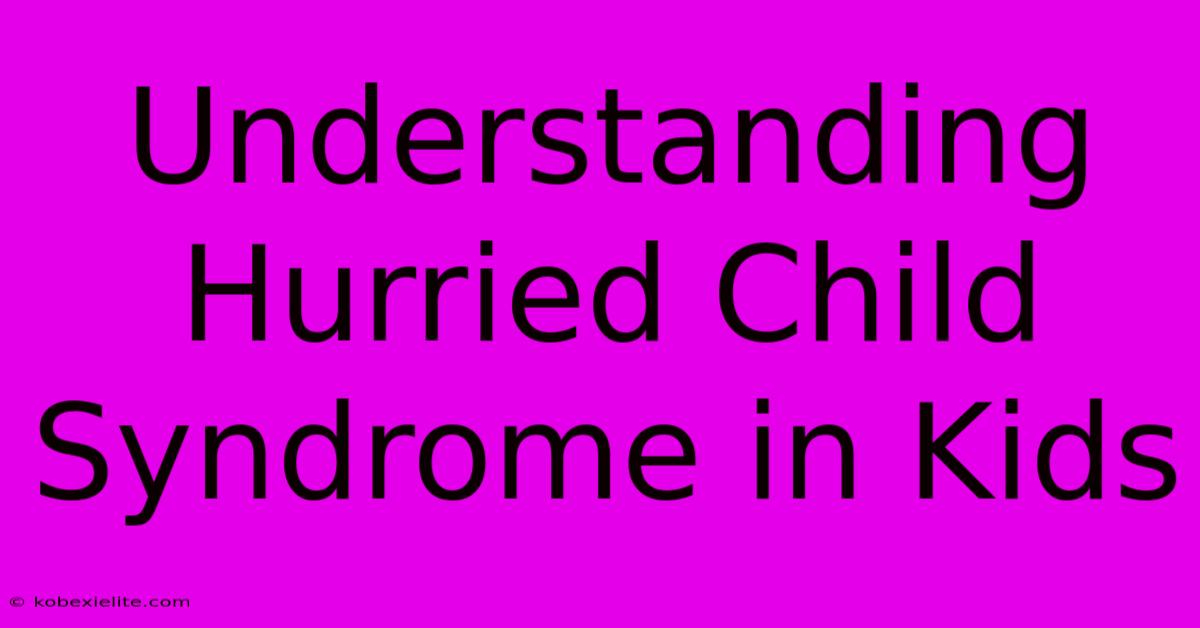Understanding Hurried Child Syndrome In Kids

Discover more detailed and exciting information on our website. Click the link below to start your adventure: Visit Best Website mr.cleine.com. Don't miss out!
Table of Contents
Understanding Hurried Child Syndrome in Kids
Are you constantly rushing your child from one activity to the next? Do you feel the pressure to ensure they're achieving milestones ahead of schedule? You might be unknowingly contributing to Hurried Child Syndrome. This isn't a clinical diagnosis found in the DSM-5, but rather a concept describing the negative impact of over-scheduling and excessive pressure on children's development and well-being. This article delves into the causes, symptoms, and long-term effects of Hurried Child Syndrome, offering strategies for parents and caregivers to foster a more balanced and nurturing childhood.
What is Hurried Child Syndrome?
Hurried Child Syndrome, a term coined by educator and author David Elkind, describes the detrimental effects of pushing children to grow up too quickly. It's characterized by a relentless schedule packed with activities, academic pressures, and adult expectations, leaving little room for unstructured play, downtime, and simply being a child. The core issue lies in the adult's desire to accelerate the child's development, often driven by societal pressures, parental ambition, or a fear that their child will fall behind.
Key Characteristics of a Hurried Child:
- Over-scheduled: Constantly involved in extracurricular activities, lessons, and tutoring, leaving minimal time for free play and relaxation.
- High levels of stress and anxiety: Feeling pressured to achieve, perform, and meet adult expectations.
- Lack of autonomy: Limited opportunities to make their own choices and explore their interests independently.
- Burnout: Exhaustion, both physically and emotionally, due to an overwhelming schedule.
- Compromised social-emotional development: Difficulties forming healthy relationships, managing emotions, and developing self-esteem.
Causes of Hurried Child Syndrome
Several factors contribute to the rise of Hurried Child Syndrome:
- Societal pressures: The emphasis on achievement and competition in today's society puts immense pressure on children to excel academically and extracurricularly.
- Parental ambition: Parents may project their own unfulfilled ambitions onto their children, pushing them to achieve what they couldn't.
- Fear of falling behind: Parents may fear that their child will be disadvantaged if they don't keep up with their peers.
- Lack of awareness: Many parents unknowingly contribute to Hurried Child Syndrome, unaware of the negative consequences of their actions.
- Competitive parenting: A culture where parents compete to boast about their children's accomplishments can exacerbate the problem.
Symptoms of Hurried Child Syndrome
Recognizing the signs of Hurried Child Syndrome is crucial for intervention. Symptoms may manifest differently in each child, but some common indicators include:
- Physical symptoms: Headaches, stomachaches, sleep problems, and decreased appetite.
- Behavioral symptoms: Irritability, anxiety, difficulty concentrating, withdrawal, and acting out.
- Emotional symptoms: Feelings of overwhelm, pressure, low self-esteem, and a lack of joy in activities.
- Academic struggles: Despite high academic pressure, performance may decline due to stress and burnout.
Long-term Effects of Hurried Child Syndrome
The consequences of Hurried Child Syndrome can extend far beyond childhood. Untreated, it can lead to:
- Mental health issues: Increased risk of anxiety, depression, and other mental health disorders.
- Substance abuse: A way to cope with stress and pressure.
- Relationship difficulties: Challenges in forming and maintaining healthy relationships.
- Lower self-esteem: A persistent feeling of inadequacy and self-doubt.
- Difficulty with adult responsibilities: Problems managing stress, time, and responsibilities in adulthood.
Preventing and Addressing Hurried Child Syndrome
The key to preventing and addressing Hurried Child Syndrome lies in prioritizing the child's well-being and fostering a balanced lifestyle. Here are some strategies:
- Prioritize unstructured play: Allow ample time for free play, exploration, and imagination.
- Limit extracurricular activities: Focus on a few activities that genuinely interest the child, rather than over-scheduling them.
- Encourage downtime and relaxation: Build in time for rest, relaxation, and family time.
- Promote autonomy and independence: Allow the child to make choices and explore their interests independently.
- Foster a positive self-image: Encourage self-acceptance and build self-esteem.
- Practice mindfulness and stress management techniques: Teach your child healthy coping mechanisms.
- Seek professional help: If you suspect your child is struggling with Hurried Child Syndrome, seek guidance from a therapist or counselor.
Conclusion:
Hurried Child Syndrome is a significant concern impacting children's well-being. By understanding its causes, symptoms, and long-term effects, parents and caregivers can take proactive steps to create a more nurturing and balanced environment for their children, allowing them to thrive emotionally, socially, and academically. Remember, childhood is a precious time—let's not rush it.

Thank you for visiting our website wich cover about Understanding Hurried Child Syndrome In Kids. We hope the information provided has been useful to you. Feel free to contact us if you have any questions or need further assistance. See you next time and dont miss to bookmark.
Featured Posts
-
Service Restoration Community Fibre
Feb 18, 2025
-
Sandler Nicholsons Rare Snl Appearance
Feb 18, 2025
-
Michigan Defeats Michigan State
Feb 18, 2025
-
Dame Judi Denchs New Role
Feb 18, 2025
-
What Is Hurried Child Syndrome
Feb 18, 2025
